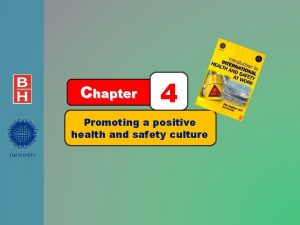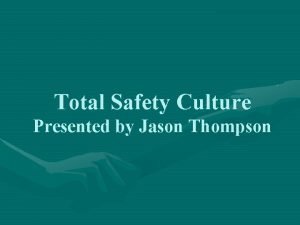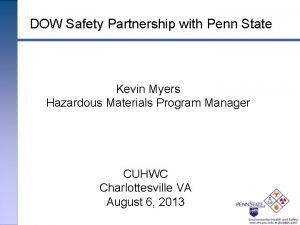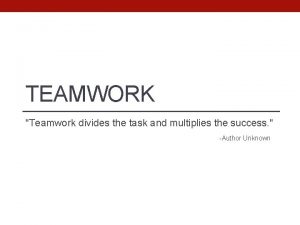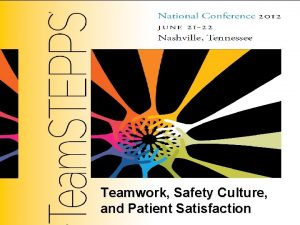Measuring teamwork and safety culture climate across 3

























- Slides: 25

Measuring teamwork and safety culture (climate) across 3 adult intensive care units of a single hospital cluster in Hong Kong Sammei Tam 18 Oct 2009 1

Why study this topic? • Patient safety is an important component in health care quality • Many errors are potentially preventable • Communication breakdown is a common cause of serious adverse events • Encourage to improve patient safety culture and promote team functioning in current healthcare practice (Institute of Medicine Report 1999) 2

Overseas experience • Huang, et al. , Critical Care Medicine (2007) – Significant safety culture variation existed across ICUs of a single institution – Nurses had lower mean scores than Doctors 3

Overseas experience • Kaissi, et al. , Nursing Economics (2003) – Measured teamwork and patient safety attitudes in high-risk areas – No significant difference between 4 hospitals – Nurses favoured team approach, but • Teamwork in departments not very advanced • Problematic communication with some key team members 4

Overseas experience • Thomas, et al. , Critical Care Medicine (2003) – Discrepancy in attitudes on teamwork amongst critical care nurses and physicians – Physicians: more satisfied with physician-nurse collaboration than nurses – Nurses: difficulty in speaking up, disagreements not appropriately resolved – Individuals ranking lower in a hierarchy: often not being asked for comments or information in relation to patient safety 5

This Study • Aims and Objectives – Primary objective : to determine whether teamwork and safety culture (climate) vary between different units in the NTEC cluster – Ultimate aim : to improve team work and patient safety in ICUs • A self-completed structured questionnaire with a few semi-structured questions – Anonymous, voluntary • Subjects and Target Population – All doctors and nurses working in the 3 ICUs – ICU Doctors n = 25 – Nurses n = 184 6

Methodology – Questionnaire Design • Adapted from …Original SAQ-ICU…included 64 items and assessed six safety culture factors. (Sexton, et al. , 2006) • For this study purposes, only the teamwork climate and safety climate factors were used • Each factor is made up of a set of individual questions (10 items in a set for safety and 10 items in a set for teamwork) • When taken together, they comprised a respondent’s perception of the factor • Some of the SAQ-ICU items were rewritten to suit the Chinese language 7

Methodology – Questionnaire Design Factor Definition Example Items Teamwork Climate Perceived quality of collaboration between ICU Doctors and ICU Nurses I have the support I need from other staff to care for patients Safety Climate Perceptions of strong and proactive organizational commitment to patient safety This unit is putting effort to ensure patient safety Modified from Sexton, et al. , . BMC Health Services Research, (2006) 8

Methodology – Questionnaire Design • Final questionnaire contained 30 items • Section A : 2 demographic questions • Section B : 20 Likert scale questions for Culture Factors • Section C : 2 Likert scale questions for impression of collaboration and communication • Section D : 3 multiple-choice (yes or no) questions for incident reporting • Section E : 3 open-ended questions for other comments 9

Pilot study • 5 senior nurses were asked to participate in a content validity exercise to rank the questionnaire in terms of comprehension and appropriateness, and whether the questionnaire retained original meanings 10

Methodology • Ethical Approval from the Joint CUHK-NTEC Clinical Research Ethics Committee • Approval obtained from CCE and senior hospital management • Questionnaire distributed and collected between January and February 2008 11

Methodology • Analysis – Descriptive analysis to determine the frequency of response for each survey item – Compare mean factor scores by ANOVA – Compare percent-favourable scores by Chi-square between each unit and between doctors and nurses • Mean factor score provides a rough point estimate about the factor score of the relevant group • Percent-favourable score is a measure of the % of respondents that gave positive response, i. e. mean score of higher or equal than 75 12

Results • Response Rates – 209 questionnaires handed out – A total of 135 questionnaires were received – One questionnaire was excluded because more than half of the data missing – Total valid questionnaires were then counted as 134 – An overall response rate was 64. 11% Response Rates Respondents Doctors Nurses Unit Rec. (n) Adm. (n) % A 71 104 68. 27 5 10** 50. 00 66 94 70. 21 B 53 69 76. 81 7 11 63. 64 46 58 79. 31 C 10 36 27. 78 1 4 25. 00 9 32 28. 13 All 134* 209 64. 11 13 25 52. 00 121 184 65. 76 . *One subject was excluded because of over 50% of missing items. **Only full time, core ICU staff were administrated the questionnaire 13

Results Differences of Perception across ICUs • The safety factor scores among the three ICUs were very close to each other and also the teamwork factors scores • ICUs did not uniformly have high factor scores or low factor scores • The percentages of staff members of a given group with favourable scores > 75 on safety and teamwork factors were less than half Mean Score Teamwork % favourable Score Safety Unit A 69. 86 63. 63 38. 03 14. 08 Unit B 68. 87 63. 00 32. 08 22. 64 Unit C 68. 51 65. 00 40. 00 10. 00 P value 0. 836 0. 921 0. 978 0. 269 Safety Teamwork 14

Results Differences of Perception between Staff Groups • Discrepancies in perceptions between doctors and nurses • Doctors tended to perceive the factors more positively than nurses • Ratings for safety factor by all nurses and doctors were higher than for teamwork factor Mean Score Safety Teamwork 70. 39 % favourable Score Safety Teamwork All Doctors 72. 31 46. 15 30. 77 All Nurses 69. 05 62. 87 34. 71 13. 43 P value 0. 276 0. 032* 0. 588 0. 496 *Statistically significant 15

Results Differences of Perception between Staff Groups for individual ICUs • Significant differences found in Unit A & Unit C; Dr perceived more positively • Nurses at Unit B had a higher rating on safety factor than doctors; Highest % on Teamwork among nurses • None of the nurses in Unit C responded favourably towards teamwork Unit A Doctor Nurse P value Unit B Doctor Nurse P value Unit C Doctor Nurse P value Mean Score Safety Teamwork 79. 50 69. 13 0. 018* 67. 15 69. 29 0. 493 80. 00 67. 22 0. 137 76. 50 62. 65 0. 014* 63. 93 63. 21 0. 887 85. 00 62. 28 0. 017* % favourable Score Safety Teamwork 60. 00 36. 40 0. 049* 28. 57 32. 61 0. 656 100. 0 33. 33 0. 046* 40. 00 12. 12 0. 125 28. 57 21. 74 0. 569 100. 00 - *Statistically significant 16

Results Response to Incidents Reporting • Only 130 out of 134 respondents had answered • 52 (Nurse n=47, Dr n=5) out of 130 have involved in patient safety related incidents • 14 out of 52 did not report incidents provided reasons: – may not be blame free – not anonymous – near miss incidents and immediately corrected by colleagues 17

Results Perceptions on Communications • Discrepant attitudes about collaboration and communication between doctors and nurses • Doctors perceived more satisfactory in communication than nurses • All differences reported were not statistically significant 18

Results Summary of comments on patient safety Patient Safety Comments (n=135) Received Procedure guidelines & practice issues 40 29. 6% Education, supervision, empowerment 28 20. 7% Duty arrangement, workload, day off & staffing 25 18. 5% Communication, morale, relationship 23 17. 0% System, culture change, incident reporting, fairness 11 8. 1% Resources, equipment, space 8 5. 9% 135 100% Total 19

Results Summary of comments on teamwork Teamwork Comments (n=119) Received Communication, regular meeting 32 26. 9% Leadership style, culture, morale 26 21. 8% Workload, working condition, fairness 26 21. 8% Relationship, mutual respect, polite, no blame 23 19. 3% Social function, staff welfare, team building activities 12 10. 1% Total 119 100% 20

Conclusions • Minimal differences on safety and teamwork climate exist across the ICUs within the cluster • Doctors were more positive in their perceptions of safety and teamwork than nurses in their working units • Doctors perceived communication more satisfactory than nurses • Findings were consistent with previous studies using SAQ in ICU • Reluctance to report incidents to supervisors 21

Recommendations 1. Repeat survey periodically to monitor culture change 2. Efforts should better direct to team-based training 3. Promote a positive working environment, result in good teamwork, enhance job satisfaction and improve nurse morale 4. Provide a starting point for understanding patient safety culture issues to leaderships in future planning of improvement programme 22

Acknowledgement All ICU doctors and nurses in NTEC for their participation and support. THANK YOU! 23

Questionnaire (2 pages double sided) 24

Questionnaire 25
 Team work poems
Team work poems Climate change 2014 mitigation of climate change
Climate change 2014 mitigation of climate change Leadership across culture
Leadership across culture Edl positive school culture & climate
Edl positive school culture & climate Ethnocentrism examples
Ethnocentrism examples Batch culture vs continuous culture
Batch culture vs continuous culture American culture vs indian culture
American culture vs indian culture Stroke culture method
Stroke culture method Folk culture and popular culture venn diagram
Folk culture and popular culture venn diagram Examples of mass culture
Examples of mass culture Stroke culture method
Stroke culture method Homework due today
Homework due today Anaerobic gaspak
Anaerobic gaspak Lawn culture method
Lawn culture method Surface culture deep culture and esol
Surface culture deep culture and esol Erscs
Erscs Promoting a positive health and safety culture
Promoting a positive health and safety culture Sociologists define a symbol as
Sociologists define a symbol as Batch culture vs continuous culture
Batch culture vs continuous culture Collectivistic cultures
Collectivistic cultures Sub culture group
Sub culture group Adaptive culture from inert culture
Adaptive culture from inert culture Laying the foundation for a quality culture
Laying the foundation for a quality culture Total safety culture
Total safety culture Safety culture in aviation industry
Safety culture in aviation industry Dow safety culture
Dow safety culture
















